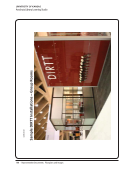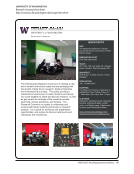58 · Survey Results: Survey Questions and Responses
Combining the ‘cultures’ of two previously distinct units has been a challenge, though staff are rising to the occasion.
I believe we anticipated the challenges well. And as I stated, this last shift had the benefit of the four larger libraries
already having made the transition.
In a situation that I inherited and with a decision already made, we initially experienced resistance from some music
department faculty to the notion of sharing services and staff. It was not clear to what degree previously agreed upon
decisions had been discussed with/communicated to them.
Increased demand on facilities staff to configure and reconfigure spaces for multiple events in one day. Pressure for non-
research related events due to temporary closure of student union building.
Integrating branch library collections into main library was complicated and time consuming. It was difficult to maintain
open communication with affected faculty. Maintaining staff morale.
Librarian resistance to student-initiated appointments without text description of need unanticipated. Accommodation
of text description greatly reduced librarian reluctance with appointment model. Note: Appointment not intended as
consultation, but as extension of increasing instructional role of reference transactions and less fact-based students
requiring further assistance can be referred to appropriate subject librarians.
Librarians began to feel disengaged from their customers (especially students) and struggled to find ways to stay
connected. Librarians also had trouble giving up a function they really enjoyed and valued, and which had been a
central part of their job (and, perhaps, the reason they became librarians) for a very long time. Hiring, training, and
retaining classified staff that have the necessary skills to be effective as on-demand reference providers has been an
ongoing challenge. Staff who acquire these skills often go on to get their library degrees and then move on to other
institutions.
More administrative time and attention was needed, e.g., more time was spent in cross training, there was a longer,
steeper learning curve for GAAs, desk scheduling was more complex. More time commitment to hire, recruit GAA
students jointly, and to select GAAs who were interested in and willing to learn two different sets of academic
disciplines. Staff acceptance of the dual roles needs to be reinforced continually.
More crowded for reference. Very little room to collaborate with patrons.
No unexpected challenges occurred. (5 responses)
Ongoing confusion regarding reasons for library closure. Continued need to demonstrate library commitment to faculty
and students in the affected field. Need to take consistent approach to changes, especially redefinition of faculty and
staff responsibilities, across service model changes that are defined by individual experiences and opportunities.
Ongoing physical repairs, additions, and improvements to the furniture, equipment, and space. Complexity of training
for all the service desk staff.
Rapid changes to technology meant we had to keep investigating options until it was purchased. We had to update
some parts of the technology infrastructure very soon after we renovated the space. Not all the work was able to be
completed on time.
Scaling training and developing on the fly, tiered reference. Although reference desk disappeared, reference staff moved
into Circulation space, still ended up with three desks/windows. Reference staff and circulation staff operate differently
(some schedule and sit at desk and wait for questions, others sit at desks in open and get interrupted constantly).
Combining the ‘cultures’ of two previously distinct units has been a challenge, though staff are rising to the occasion.
I believe we anticipated the challenges well. And as I stated, this last shift had the benefit of the four larger libraries
already having made the transition.
In a situation that I inherited and with a decision already made, we initially experienced resistance from some music
department faculty to the notion of sharing services and staff. It was not clear to what degree previously agreed upon
decisions had been discussed with/communicated to them.
Increased demand on facilities staff to configure and reconfigure spaces for multiple events in one day. Pressure for non-
research related events due to temporary closure of student union building.
Integrating branch library collections into main library was complicated and time consuming. It was difficult to maintain
open communication with affected faculty. Maintaining staff morale.
Librarian resistance to student-initiated appointments without text description of need unanticipated. Accommodation
of text description greatly reduced librarian reluctance with appointment model. Note: Appointment not intended as
consultation, but as extension of increasing instructional role of reference transactions and less fact-based students
requiring further assistance can be referred to appropriate subject librarians.
Librarians began to feel disengaged from their customers (especially students) and struggled to find ways to stay
connected. Librarians also had trouble giving up a function they really enjoyed and valued, and which had been a
central part of their job (and, perhaps, the reason they became librarians) for a very long time. Hiring, training, and
retaining classified staff that have the necessary skills to be effective as on-demand reference providers has been an
ongoing challenge. Staff who acquire these skills often go on to get their library degrees and then move on to other
institutions.
More administrative time and attention was needed, e.g., more time was spent in cross training, there was a longer,
steeper learning curve for GAAs, desk scheduling was more complex. More time commitment to hire, recruit GAA
students jointly, and to select GAAs who were interested in and willing to learn two different sets of academic
disciplines. Staff acceptance of the dual roles needs to be reinforced continually.
More crowded for reference. Very little room to collaborate with patrons.
No unexpected challenges occurred. (5 responses)
Ongoing confusion regarding reasons for library closure. Continued need to demonstrate library commitment to faculty
and students in the affected field. Need to take consistent approach to changes, especially redefinition of faculty and
staff responsibilities, across service model changes that are defined by individual experiences and opportunities.
Ongoing physical repairs, additions, and improvements to the furniture, equipment, and space. Complexity of training
for all the service desk staff.
Rapid changes to technology meant we had to keep investigating options until it was purchased. We had to update
some parts of the technology infrastructure very soon after we renovated the space. Not all the work was able to be
completed on time.
Scaling training and developing on the fly, tiered reference. Although reference desk disappeared, reference staff moved
into Circulation space, still ended up with three desks/windows. Reference staff and circulation staff operate differently
(some schedule and sit at desk and wait for questions, others sit at desks in open and get interrupted constantly).






















































































































































































































